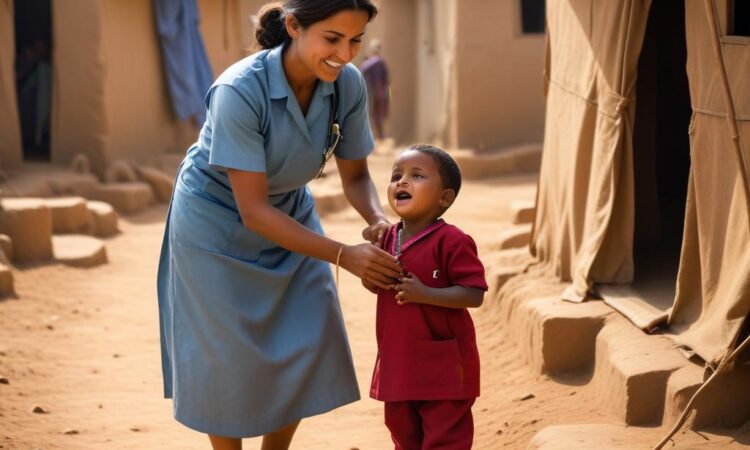Poliovirus Resurgence in Multiple Countries
The world is facing a concerning resurgence of poliovirus outbreaks in several regions, highlighting the urgent need for intensified vaccination campaigns and a renewed focus on improving sanitation and hygiene practices. Reports from the World Health Organization (WHO) and UNICEF paint a grim picture, revealing the challenges in reaching vulnerable populations and eradicating this debilitating disease.
Polio, a highly infectious disease caused by the poliovirus, primarily affects children under five years old. The virus attacks the nervous system, potentially leading to irreversible paralysis. While a highly effective vaccine exists, significant gaps remain in global vaccination coverage, allowing the virus to spread and re-emerge in regions where it was previously considered eradicated or controlled.
Several factors contribute to this resurgence. Firstly, inconsistent vaccination campaigns leave pockets of unvaccinated or under-vaccinated children vulnerable to infection. Complex logistical challenges, including security concerns, conflict, displacement, and limited access to healthcare facilities in remote areas, hinder efforts to reach these populations. Furthermore, misinformation and vaccine hesitancy continue to undermine public health initiatives, preventing widespread uptake of the life-saving vaccine.
Beyond vaccination, improving sanitation and hygiene plays a crucial role in preventing polio transmission. The poliovirus is primarily spread through the fecal-oral route, meaning it can easily spread in areas with inadequate sanitation systems and poor hygiene practices. Contaminated water sources, inadequate sewage disposal, and insufficient handwashing facilities create breeding grounds for the virus, increasing the risk of outbreaks.
The WHO and UNICEF are working tirelessly to address these challenges. They are collaborating with governments and local communities to strengthen vaccination programs, improve surveillance systems to detect outbreaks quickly, and promote better sanitation and hygiene practices. These efforts involve community mobilization, health worker training, and the development of innovative strategies to reach marginalized communities.
However, overcoming this resurgence requires a concerted global effort. Increased funding is essential to support vaccination campaigns and improve sanitation infrastructure. Furthermore, addressing misinformation and building public trust in vaccines is crucial. Effective communication campaigns can help dispel myths and anxieties surrounding vaccination, encouraging greater participation in immunization programs.
The consequences of failing to address the poliovirus resurgence are severe. Not only does it lead to individual suffering and lifelong disability, but it also undermines progress towards global polio eradication. The virus can easily spread across borders, posing a threat to even countries with high vaccination rates. Therefore, a global commitment to improving sanitation, bolstering vaccination programs, and fostering community engagement is vital to contain and ultimately eliminate this devastating disease.
The current situation demands a multifaceted approach. This includes:
- Strengthening vaccination campaigns: Ensuring high vaccination coverage rates, particularly among vulnerable populations, is paramount. This involves targeted outreach programs, addressing vaccine hesitancy, and improving vaccine delivery systems.
- Improving sanitation and hygiene: Investing in improved sanitation infrastructure, including access to clean water and sanitation facilities, is crucial in preventing the spread of the virus. Promoting handwashing and hygiene education within communities is also essential.
- Enhanced surveillance and outbreak response: Effective surveillance systems are crucial for early detection and rapid response to outbreaks. This includes improving laboratory capacity and strengthening epidemiological investigations.
- Community engagement and education: Building trust and understanding within communities is crucial for successful vaccination campaigns and the adoption of improved hygiene practices. This involves working with community leaders and using culturally appropriate communication strategies.
- International collaboration: Polio eradication requires international cooperation and coordination. Sharing best practices, resources, and technical expertise is vital for effective global efforts.
The resurgence of poliovirus underscores the fragility of progress achieved in global health. It serves as a stark reminder of the importance of continued vigilance, investment in public health infrastructure, and a commitment to reaching every child with the life-saving polio vaccine. The combined efforts of governments, international organizations, and communities are essential to overcome this challenge and prevent future outbreaks.
The long-term success in eradicating poliovirus hinges on sustainable improvements in sanitation and hygiene infrastructure, coupled with consistent and comprehensive vaccination programs. Only through a sustained and collaborative effort can we hope to protect future generations from this devastating disease.
Further research and development into improved vaccines and delivery mechanisms are also necessary to enhance the effectiveness and accessibility of immunization programs, particularly in challenging settings.
The fight against polio is far from over. It requires ongoing commitment, resources, and innovative strategies to overcome the obstacles that hinder progress towards global eradication. The world must remain vigilant and dedicated to ensuring that every child has access to the protection they need.
The scale of the challenge is immense, but the potential rewards – a polio-free world – are equally significant. By strengthening our collective efforts, we can bring an end to this debilitating disease and safeguard the health of future generations.
This resurgence serves as a wake-up call, reminding us of the importance of investing in public health infrastructure and maintaining robust immunization programs. The cost of inaction far outweighs the investment needed to protect global health security.
The ongoing challenges highlight the need for a more comprehensive and equitable approach to global health, one that prioritizes the needs of the most vulnerable populations and addresses the underlying social and economic factors that contribute to outbreaks.
Ultimately, the eradication of polio requires a sustained global commitment, one that recognizes the interconnectedness of health, sanitation, and economic development. Only through collaboration and concerted action can we hope to achieve a polio-free future.
The situation calls for a renewed sense of urgency and a commitment to addressing the root causes of the resurgence. This includes tackling vaccine hesitancy, improving access to healthcare, and investing in sustainable sanitation and hygiene infrastructure.
The fight against polio continues, and the international community must remain steadfast in its commitment to eradicating this devastating disease once and for all.

